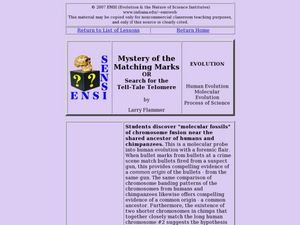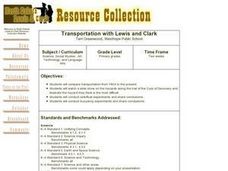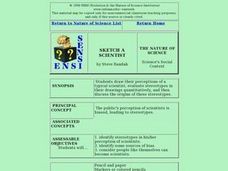Curated OER
Mystery of the Matching Marks
High schoolers view a Power Point and complete activities related to genetic evidence of human evolution. In this molecular evolution lesson, students view and discuss a provide presentation. They search for the "tell-tale telomere" and...
Curated OER
Andy Warhol and Silkscreen Pop Art
Students explore art history by researching famous paintings on-line. In this Andy Warhol lesson, students discuss who Warhol was, his impact on popular art and methods of painting. Students examine his use of silk screen printing and...
Curated OER
Pseudogene Suite
High schoolers use Biology Workbench to explore DNA sequence data for the GULOP gene in humans, chimpanzees, orangutans, and crab-eating macaques and the beta globin gene and its pseduogene in humans, gorillas, and chimpanzees.
Curated OER
Comparison of Human and Chimpanzee Chromosomes
Young scholars actively engage in the careful analysis of chromosome banding patterns and identify examples of inversion in homologous chromosomes.
Curated OER
Transportation with Lewis and Clark
Students listen to a PowerPoint presentation and complete a Venn diagram comparing the methods of transportation in the early 1800s with today's transportation. They experiment with the buoyancy of keelboats.
Curated OER
Lesson Plan: The Cell- A Historical Perspective
Students discover the impact the invention of the microscope had on scientific discovery as well as the concept of spontaneous generation and the cell theory. Students examine these scientific concepts through a WebQuest and by viewing a...
Curated OER
An Introduction to Dichotomous Keys
Young scholars pretend to be shark biologists employed by the National Oceanic and Atmospheric Administration (NOAA) who have been flown into the coastal city of Sao Luis in Brazil because locals have noticed an unidentified shark at...
Curated OER
Community Service
Studen collect trash around the community with trash bag and gloves. They recognize and describe ways that some materials
Curated OER
Genetic Jewels: Building the DNA Model
Students construct segments of DNA to create a piece of jewelry. In this genetics activity students create a DNA sequence that they turn into something to wear.
Curated OER
What did T. rex taste like?
Students examine the three domains of life and explain that all living things share a common ancestor. In this paleontology lesson plan students are introduced to the process of illustrating evolutionary relationships.
Curated OER
Biodiesel Combustion and Its Influences in NOx Emissions
Tenth graders evaluate the physical mechanisms that cause a change in NOx emissions. In this combustion lesson, 10th graders participate in a research project. Students create a presentation of their findings.
Curated OER
FOOTSTEPS IN TIME
Students measure and correlate their foot lengths and body heights, then use this data to estimate height of Laetoli hominids. They use metric measurement and graphing to determine these heights.
Curated OER
The Flat Earth
Students are first presented with the idea that the Earth is really flat. They prove that it is not--using a variety of techniques.
Curated OER
The Great Volume Exchanger...or the Magic Matter Maker ®
Students pour water into a "magic" box and examine how it comes out with a much larger volume of water. They, working in small groups, design a volume exchanger and explain its design to the whole class.
Curated OER
Palpating Pachyderms: How Do We Interpret Observations?
Students interpret a poem before completing activities to distinguish observations and interpretations. They examine how personal background can influence how a person interpreters what they observe.
Curated OER
Sugar Bush Sap Production - Human Environmental Impact on Sap Sand
Eleventh graders compare the amount of sugar sand present in tree sap. In this environmental science lesson, 11th graders measure different tree circumference. They prepare a report and share findings in class.
Curated OER
Sketch a Scientist
Young scholars draw their perceptions of a typical scientist, evaluate stereotypes in their drawings quantitatively, and then discuss the origins of these stereotypes.
Curated OER
Warm and Cold Air
Students examine what happens to air when it is heated or cooled. They conduct an experiment using bottles and balloons, record and discuss their observations, and write a hypothesis.
Curated OER
A Crime Against Plants
Students research the phenomenon that is living in a small tree. They develop their own conclusion on what they believed is occuring. They answer discussion questions to end the lesson.
Curated OER
Find the Washer
Pupils examine a closed box with wires and try to guess where the washer is. They experiment by pulling out wires to determine the location of the washer. They complete discussion questions to end the lesson.
Curated OER
Three-Hole Bottle
Middle schoolers participate in an experiment with a 2-liter bottle. They develop their own hypothesis about what they believe will happen when certain items are tested on the bottle. They discuss results.
Curated OER
Cloud Shadows
Students classify clouds as transparent, translucent or opaque. They conduct an experiment to determine the visual opacity of several classroom objects and then conduct further observations of clouds.
Curated OER
Cloud Databases
Students complete a unit on clouds and a report about one type of cloud. They collect data through observation about different types of cloud cover and then create a spreadsheet to reflect their observations over a 2 week period.
Curated OER
Bird Populations
learners study bird migratory patterns and the methods that researchers use to study them. Students are introduced to the concepts of the study of bird movements.The skill of scientific questioning is used to find results.
Other popular searches
- History and Nature of Science
- The Nature of Science
- Nature of Science Biology
- Nature of Science Inquiry
- Nature of Science Physics
- History Nature of Science
- Science Patterns in Nature
- Genetics Nature of Science
- Teaching Nature of Science
- Nature of Science Weather
- Genetic Nature of Science
- Science and Nature

























